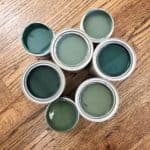My husband and I tackled our first DIY project in our new home together, and it was a Dark Shiplap Wall. It turned out ABSOLUTELY amazing, and we wanted to share our process with others! This is a beginner friendly tutorial with lots of tips, so you can achieve this amazing accent wall in your home too!

In our home, we have a front office space that I work out of as a freelance makeup artist. The room has a pretty huge wall, which is perfect for a fun accent wall! I always wanted to do something with it and finally made the decision to create a shiplap wall. Shiplap walls are pretty popular these days, but I didn’t want it to be traditional looking. I really liked the look of a more modern, moody shiplap wall that would compliment the deep navy blue colors in my rug.
My husband and I have never done a shiplap wall before, nor any major DIY project in our house (this will be the first of many!), and I am super proud of us and the final result. It really came out pretty amazing and it wasn’t too difficult.
BEFORE:

after:

A DIY SHIPlap Wall is ACHIEVABLE, Even With Small Children
We do have 2 small children (3 year old and 1 year old) so it took us a total of 5 days to complete the project. In order to get this project done, we basically worked mainly at night after putting the kids to bed and a couple hours during the afternoon when they napped. It is totally doable with small children, you just have to be patient and know it may take you a little longer 🙂

Our wall was also pretty huge (16.5 ft wide and 9 ft tall). If you have a smaller wall to shiplap, you can probably get this done in half the time!
Beginner Friendly SHIPlap Wall Tutorial
Since this was our first DIY project, we learned a lot during the whole process and wanted to share a very detailed step-by-step guide for you. My husband has some experience in carpentry and woodwork which helped, but I am just a regular stay-at-home mom with big ideas! My husband always loves to hear my ideas (*sarcasm*). Ha-ha!
I did refer to several online sources for help such as ChrisLovesJulia’s tutorial, but wanted to include extra tips and details in our tutorial for you guys. My husband thinks this may be too detailed, but honestly…I wanted this to be achievable and stress free for the most newbie person out there. Basically, the guide I wish I had!
Hopefully this simple and thorough step-by-step guide will help you achieve this fun and easy shiplap wall in your home, too. It really gives your space instant texture and character!
Before you start your SHIPlap Wall project
Before you get started, you will first need to figure out what tools and materials you will need to buy. Some of these tools you may already have at home, but others you will most likely need to spend money on. As a newbie DIY girl, I learned that having the right tools is key in making your DIY projects go smoothly and efficiently!
Here are the list of tools and materials we used to complete this project.
Tools Needed:
- Jigsaw (key when creating smaller, precise cuts around outlets)
- Miter Saw (key for cutting planks to our custom lengths and for cutting trim)
- Airstrike Nail Gun (or regular hammer–but trust me, a nail gun will make this project go so much faster! Seriously the best tool to invest in!)
- Long Level
- Chalk Reel (HIGHLY recommend!)
- Tape Measure
- Carpenters Square or Ruler
- Stud Finder
- Paint Roller & Brush
- Putty Knife
- Sandpaper
- Nickels or 1/8″ Spacers
- Frog Tape (the best at getting crisp straight lines–especially when painting on textured walls).
Materials Needed:
- 5mm 4×8 Underlayment Plywood Boards (we used 5 and were $16 a board)
- 1.5″ Trim (optional–but we liked the look of a finished frame which also helped hide imperfections along the edges).
- Paint (We used “Night View” by Valspar)
- 2″ Brad Nails (if using a nail gun–but if using a regular hammer, use finishing nails)
- Spackle
TOTAL COST: $533.50
Contractors originally quoted us a couple thousand dollars to do this wall, so by doing it our selves, we saved quite a bit of money! We also had more upfront costs because we needed to invest in a few tools. Our cost may not be what it will cost you…just depends on what tools and materials you already own.
So now that you know what you will need, you can start planning and making the shiplap wall! Woo-hoo!
DIY dARK SHIPLAP waLL sTEP-BY-sTEP tUTORIAL

Step 1: Determine Panel Sizes And Staggered Pattern
My husband is the left brained person in the relationship and was the brains behind the calculations and design of the shiplap wall. When creating a shiplap wall, you want to stagger the panels so that the seams are slightly offset. This may require some planning so that you use your wood supplies as efficiently as possible.

Calculate your desired panel height and widths
Our wall was 16.5′ feet wide and about 9′ feet tall. The underlayment plywood boards at Home Depot came in 4ft x 8ft boards, which calculated out to 5 boards to cover our wall.
Because our wall was so huge and slightly longer than 16 ft, we needed to create 3 different panel lengths and staggered designs. I also wanted a more “wide” paneled look, so we calculated that 8″ wide panels would fit perfectly up the height of the wall.
Step 2: Buy & Cut Boards to Length
When we went to Home Depot, they were able to cut the 4 x 8 boards into the 8″ inch panels for us (which keep in mind were NOT ALL EXACTLY 8″ panels).

Home depot cut them for us for free (which was great!), but they do not guarantee every cut will be super precise. This caused us some issues when putting up the panels. Some panels were off by 1/16″ which made the panels not line up EXACT, but oh well. That’s what gives the wall that extra character! 🙂

When we brought the 8″ wide strip panels home, we cut the panels into the 3 lengths we needed for our staggered design. The Ryobi 10″ Miter Saw worked great! It doesn’t cut all the way through the full panel (it only cuts 5 1/2″ into the board), so we just flipped it over and finished the cut.

Here are the 3 panels lengths we cut. We did a 22″, 44″, and 66″ length which fit perfectly across our wall.

Below you can see us mapping out the stagger to make sure it looked good and actually fit the wall 🙂

Step 3: Find And Mark Studs
What are studs? And why are they important? This isn’t a stupid question, because as a newbie I had no clue haha. Don’t judge me!

Studs are basically these thick wood boards going up and down your wall (behind the sheet rock). They are typically spaced 16 or 24 inches apart. You want to make sure your shiplap panels are nailed directly into these studs to ensure they are safetly and securely nailed to the wall. Just nailing straight into sheet rock without nailing into the studs could put your panels at risk of just “falling off the wall.” That won’t be cute.

Once you find a stud location with your stud finder, mark it with a pencil and take out your DeWalt Chalk Reel. This chalk reel is the best! I highly recommend using this to mark your studs on the wall. It leaves a long straight chalk line down your wall very quickly and easily. No one has time to pull out a ruler and draw that long line, especially if your walls are tall!

When using the chalk reel, we hammered a small nail at the top of the wall where the stud is. Now this is how you use the chalk reel:
- Hang the chalk reel hook onto the nail and pull the reel all the way down to the ground.
- Let go of the reel and let it hang for a bit until it stops swaying and lines up straight with the wall.
- At the lower base of the reel string, press the string against the wall and give it a good flick. The reel should bounce off the wall, leaving a chalk line down your wall.


Boom! Quick and easy way to draw your stud lines on your wall.

sTEP 4: cUT aROUND oUTLETS (if YOU hAVE aNY)
We had 3 different outlets to cut holes for. One of them fell directly in between two panel seams and the others needed to be cut in the middle of the panel. I will show you how we did both types of cuts below:
Cutting An Outlet Hole in between panel seams
- Remove covers of outlets with a screwdriver.

2. Unscrew outlet plates and pull slightly off the wall in order for wood panels to fit snuggly behind them.

3. Measure the height and width of the outlet box and draw it onto your panel.


4. Use a Jigsaw to cut it out.


5. We nailed that first panel up (making sure the wood was behind the outlet plate). And measured the remaining space for the other wood panel.

6. If everything was measured and cut correctly, it should line up perfectly around the outlet like you see below.

cUTTING An oUTLET Hole IN THE MIDDLE OF bOARD
1. Measure the width and height of the outlet hole and copy that exact measurement onto your wood panel.

Key Tip: Drilling a hole into the square with an electric drill can help you get the Jigsaw cut started.


Step 5: Nail Boards to Wall With spacers
We decided to start nailing from the bottom and to use nickels as spacers to save money. I wanted the spacing to be 1/8″ wide, so we had to stack 2 nickels together to get that width.

Key Tip: Before nailing your panels, use a long level to ensure the panels are all leveled and straight. Homes often-times don’t have perfectly leveled floors or ceilings, so you may have to adjust as you go (another reason trim is useful…it will help hide any minor gaps or uneven edges in the end)!

Just in case you didn’t read this earlier, this Ryobi Airstrike Nail Gun is AMAZING! We used 2″ Brad nails, and it made the project go quickly. The sound was also quieter compared to a traditional hammer (perfect if you have small kids in the home trying to nap!).


Step 6: (optional) Nail Trim
We used 1.5″ trim to add to the top and sides of our shiplap wall. Not everyone does this, but we felt it gave the wall a more “finished” look. It’s also an easy way to hide any gaps or mistakes on the edges.


Step 6: Spackle Nail Holes And Seams
Spackling helps to hide the seams between the panels and the holes from the nails. You will need a putty knife for this part (fingers work too with the nail holes). When using your putty knife, make sure you feather out the product to create a thin, smooth, and even surface over the seams.

Key Tip: Make sure to clean your putty knife as you go by scrapping off extra product back into the bucket. Using a wet cloth to wipe the knife is also recommended. Keeping your knife clean helps when trying to create that smooth, seamless surface across your panels.


Step 7: Sand Spackle
After your spackle dries (takes a couple hours), you will want to sand down any areas that aren’t super smooth. If you paint over bumpy spackle, the surface will look uneven on your wall….so this step helps keep everything looking smooth and clean!

Step 8: Paint
We decided to use Valspar’s “Night View” from Lowe’s. It’s a beautiful deep, dark navy blue. We love Valspar paint because they can mix the primer into it which saves you a step! If your paint doesn’t have primer mixed in, you will need to prime your wall beforehand.

Key Tip: Looking back now, we recommend painting in between the panels as you put them up on the wall. It took forever to go back and paint in between every single panel! We had to use a super tiny brush to get all the hard to reach spots and it was just so tedious. Not my favorite part!

STEP 9: fINISHING tOUCHES & yOUR dONE!

There you have it… a beautiful, dark, modern shiplap wall that took less than a week to do. It probably would of gone faster, had we done this on a smaller wall and if we didn’t have small children. Ha-ha! But honestly, it was super do-able and achievable as a first DIY home project.
If you are a beginner at DIY projects and want to add character to your home, I would recommend trying to do a shiplap wall. Hopefully this guide will help you along the way and give you some courage to do it, too! 🙂




